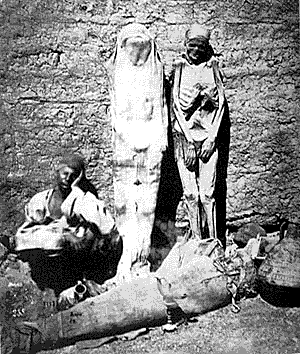by Mennat-Allah El Dorry
When you travel abroad on a holiday, you always have a huge task ahead of you – buying souvenirs for your family, friends, and yourself of course. In our modern times where airlines impose ridiculous restrictions on our weight, we always look for something light and easy to carry, and also a bunch, so you can cover yourself if you forgot about that one person who bought you that lovely scarf/pen/book/etc. from their last trip. Egypt is full of such knick knacks: king Tutankhamun magnets, pens with floating pyramids inside a gelatinous substance, or even a bust of Nefertiti. Backtrack for a few hundred years, long before magnets and pens with little pictures floating in them, the souvenir of choice for many travellers in the 18th and 19 centuries was non-other than a mummy. A real mummy.
Since Napoleon’s expedition, the interest in Egypt caused a myriad of travelers to visit the country, and purchase souvenirs to remind them of their adventures. Napoleon brought with him a group of scholars to record all that they could of Egypt’s flora, fauna, geography and monuments. This information was gathered in a multi-volume fully illustrated publication known as Description de l’Egypte. This publication, along with the antiquities that were exported form Egypt to the west, served to spark the interest of the western public and intellects in Egyptian antiquities. Mummies were especially popular as souvenirs since they were abundant, exotic, as well as relatively easy to transport.
However, once in a while transferring mummies was not a success. A story tells of two ladies who attempted to smuggle a mummy to Europe aboard their dahabiyah (house boat), but the stench of the mummy after a few days made it unbearable, and they had to dispose of it in the Nile. Another gentleman who tried to transport mummies via train was stopped and questioned by the authorities, who assumed that he was trying to dispose of the bodies he has murdered.
Tourists are always attracted by excavations, and they cannot help themselves from looking on if they happen to stumble across some archaeologists going on about their work, in hopes that something grand would be discovered in front of them. In the 18th and 19th centuries, travelers were not only rewarded with seeing objects discovered, but they themselves ‘discovered’ antiquities. Mummies were collected from here and there, and placed in touristy spots. They were unearthed when the travelers came. An example of this is a group of some 30 mummies that were ‘discovered’ together in a tomb during King Edward VII’s (then Prince of Wales) visit in 1869. These mummies were distributed to collectors in England. The tomb in which they were discovered was discovered 40 years earlier in 1830s, and was devoid of any contents except for a single sarcophagus.
Mummies sent to Europe became the stars of “mummy unwrapping” parties. These parties became grand social events. Amulets from the wrappings of the mummies were sometimes given as favors to the guests, and the unwrapped mummy would be displayed in the house, perhaps in the study of its owner.
Mummies were sometimes abused rather than showcased. In America, Their linen wrappings were used to make brown paper used by butchers. The bodies were used for making brown paint for oil paintings, cunningly named “Mummy Brown”. One artist using this color was so distraught after finding out that this color was made from actual mummies, that he buried them in his garden, giving them “a decent burial”.
Before the times of aspirin, decongestant, and effervescent vitamin C tablets, rich Europeans would carry around a pouch of a special powder. A powder that is as ancient as the world itself, a magic powder that cures all ailments and maladies. This powder is called mummia powder. Sounds familiar? Indeed, as rare and as expensive as the most exclusive spices get powder made of ground up mummies was a highly demanded commodity.
The earliest mention of the medicinal uses of mummies comes from the Greek physician and pharmacologist Dioscorides (AD 40-90) who listed it as a cure for some ailments. The earliest mediaeval mentioned comes from El Magar, an Arabic-Jewish physician living in Alexandria in the twelfth century. The various ailments that it cured include nausea, epilepsy, vertigo, abscesses, eruptions, ulcers and more. It was often mixed with other spices such as marjoram and thyme.
Even as late as 1972, there were books for doctors that listed mummy powder.
If you fancy a bit of mummia powder, there are still some being sold in Egypt near Bab Zuweila in at least one of the big spice shops along the street. But be careful though; follow the recommendations of Pierre Pomet from 1694. You should only buy good quality powder that comes from black mummies without bones or dust, ones that smell good – with the smell of something burnt, not the smell of pitch or resin.
As many mummies as there were, the demand was high, and mummies were running out. Unclaimed corpses in Alexandria had pitch and resin applied to them, and buried for a few years in someone’s backyard, until they were “ready” and were ground up and sold as mummy powder. This was a common practice in Alexandria from 1200 onwards, especially the Jews who were allowed to be involved in such practices.
Taxes were levied in the 18th century to deter them from such practices, and from corpse trafficking
Not only mummy powder was reproduced from modern corpses, but one instance recalled is that of a mummy being sold to a traveler in Aswan. He later found out that it was not an ancient Egyptian mummy after all, but the body of an English engineer who had died in Egypt. After all, “it would be hardly respectable, upon one’s return from Egypt, to present oneself without a mummy in one hand and a crocodile in another (father Géramb to Mohammed Ali in 1833)..




